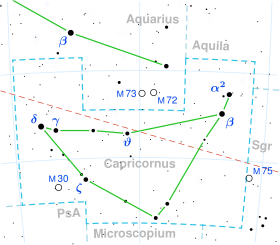 Global Information
Global InformationAlpha1 Capricorni information
 | |
| Observation data Epoch J2000.0 Equinox J2000.0 (ICRS) | |
|---|---|
| Constellation | Capricornus |
| Right ascension | 20h 17m 38.86910s[1] |
| Declination | −12° 30′ 29.5716″[1] |
| Apparent magnitude (V) | 4.27[2] + 8.60[3] |
| Characteristics | |
| Spectral type | G3 Ib[4] |
| U−B color index | +0.70[2] |
| B−V color index | +1.07[2] |
| Astrometry | |
| Radial velocity (Rv) | −25.21±0.86[1] km/s |
| Proper motion (μ) | RA: +21.800[1] mas/yr Dec.: +2.222[1] mas/yr |
| Parallax (π) | 3.7417 ± 0.1990 mas[1] |
| Distance | 870 ± 50 ly (270 ± 10 pc) |
| Absolute magnitude (MV) | −1.90[5] |
| Details[6] | |
| Mass | 5.3 M☉ |
| Radius | 36.3±2.0 R☉ |
| Luminosity | 1,047 L☉ |
| Surface gravity (log g) | 1.75 cgs |
| Temperature | 5,119±15 K |
| Metallicity [Fe/H] | −0.02 dex |
| Rotational velocity (v sin i) | 7.3[4] km/s |
| Other designations | |
Prima Giedi, Algiedi Prima[7], α1 Cap, alf-1 Cap, 5 Capricorni, BD−12° 5683, HD 192876, HIP 100027, HR 7747, WDS 20176-1230 | |
| Database references | |
| SIMBAD | data |
Alpha1 Capricorni, Latinized from α1 Capricorni, is a distant, binary star system dominated by a highly luminous star in the constellation of Capricornus, north of the ecliptic. It has the traditional star names Prima Giedi (/ˌpraɪmə ˈdʒiːdi/) and Algiedi Prima (/æˈdʒiːdi ˈpraɪmə/). The system is separated from the brighter Alpha2 Capricorni by 0.11° of the sky, a gap resolvable with the naked eye, similar to Mizar and Alcor. Both are not to be confused with much fainter 3 Capricorni nor somewhat fainter Nu Capricorni which are 3 to 6 times the angular distance apart than separate the two Alpha stars, respectively.
The primary star is a yellow hued supergiant star with a stellar classification of G3 Ib.[4] It has an apparent magnitude of +4.3; bright enough to make it visible to the naked eye. The star is located at a distance of approximately 870 light years from the solar system based on parallax measurements, but is drifting closer with a radial velocity of −25 km/s.[1] The star is past first dredge-up and has already evolved through the Cepheid instability strip; it may be about to do so a second time.[6] It has 5.3 times the mass and 36 times the radius of the Sun, and is radiating around 1,047 times the Sun's luminosity from its photosphere at an effective temperature of 5,119 K.[6]
The Hipparcos satellite in about the year 2000 found a previously undetected companion at an angular separation of 0.65″ from the primary.[8] This magnitude 8.60 star forms a binary pair with α1 Capricorni.[3] Three other faint visual companion stars lie within one arc-minute, so are unresolveable in small telescopes. The brightest of these is 10th magnitude and on this basis it has often been considered as an optical binary. Separation is increasing rapidly due to great proper motion of the primary star.[8]
- ^ a b c d e f g Cite error: The named reference
dr2was invoked but never defined (see the help page). - ^ a b c Cite error: The named reference
ducatiwas invoked but never defined (see the help page). - ^ a b Cite error: The named reference
Eggleton_Tokovinin_2008was invoked but never defined (see the help page). - ^ a b c Cite error: The named reference
aaa449_2_655was invoked but never defined (see the help page). - ^ Cite error: The named reference
Anderson2012was invoked but never defined (see the help page). - ^ a b c Cite error: The named reference
Usenko2015was invoked but never defined (see the help page). - ^ Cite error: The named reference
rumrillwas invoked but never defined (see the help page). - ^ a b Cite error: The named reference
wdswas invoked but never defined (see the help page).